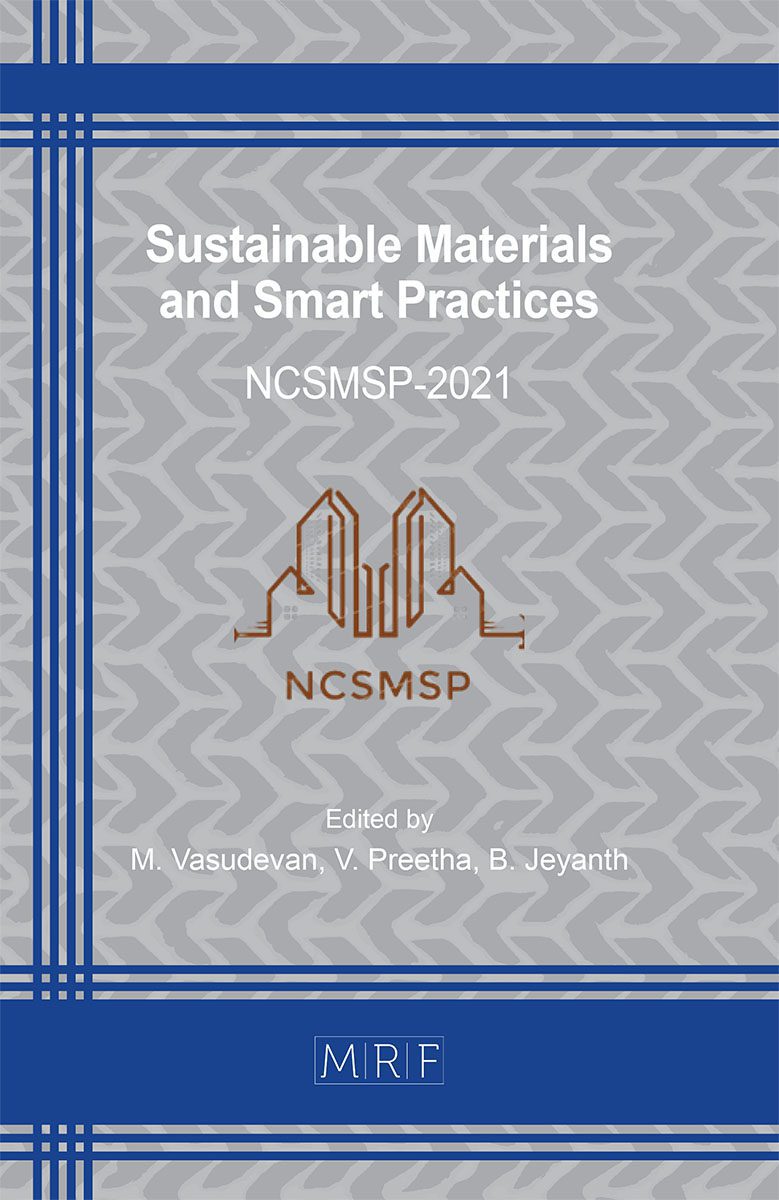Mechanical Properties of Fiber Reinforced Concrete by using Sisal Fiber with M-Sand as Fine Aggregate
V.M. Gnanasundar, T.S. Palanisamy, G.S. Thirugnanam, V. Preetha
download PDFAbstract. Conventional concrete has a low tensile strength, constrained ductility and little protection from crack propagation. The inward miniaturized scale of cracks, prompting weak disappointment of concrete. Investigations have been carried out in many countries on various mechanical properties, physical performance and durability of cement-based matrices reinforced with naturally occurring fibers including sisal, coconut, jute, bamboo, and wood fibers. Raised natural mindfulness and an expanding worry with an unnatural weather change have invigorated the search for materials that can supplant traditional engineered fiber. Characteristic fiber, for example, sisal strands show up as one of the great options since they are accessible in sinewy structure and can be separated from plant leaves, stalk, and products of the soil at exceptionally low expenses. In this work, the impact of sisal strands on the quality of cement for M25 evaluation has been examined by shifting the level of filaments in concrete. Fiber substance were shifted by 0.05%, 0.10%, 0.15%, 0.20%, 0.25%, 0.30%, 0.35% and 0.40% by volume of cement. Cubes, Cylinder and Prism were cast to assess the Compressive, Split Tensile and Flexural Strength test. Every one of the samples was tested for a time of 28 days curing. The results of fiber reinforced concrete for 28 days curing with a varied percentage of fiber were studied and it has been found that there is significant strength improvement with addition of sisal fiber in concrete.
Keywords
Sisal Fiber, Mechanical Properties, Sisal Strands
Published online , 7 pages
Copyright © 2022 by the author(s)
Published under license by Materials Research Forum LLC., Millersville PA, USA
Citation: V.M. Gnanasundar, T.S. Palanisamy, G.S. Thirugnanam, V. Preetha, Mechanical Properties of Fiber Reinforced Concrete by using Sisal Fiber with M-Sand as Fine Aggregate, Materials Research Proceedings, Vol. 23, pp 76-82, 2022
DOI: https://doi.org/10.21741/9781644901953-10
The article was published as article 10 of the book Sustainable Materials and Smart Practices
![]() Content from this work may be used under the terms of the Creative Commons Attribution 3.0 licence. Any further distribution of this work must maintain attribution to the author(s) and the title of the work, journal citation and DOI.
Content from this work may be used under the terms of the Creative Commons Attribution 3.0 licence. Any further distribution of this work must maintain attribution to the author(s) and the title of the work, journal citation and DOI.
References
[1] Mathur.V.K. “Composite materials from local resources”, Construction and Building Materials 20 (2006) 470-477. https://doi.org/10.1016/j.conbuildmat.2005.01.031
[2] Di Bella.G, Fiore.V , Galtieri.G , Borsellino.C , Valenza.A, “Effects of natural Fibre reinforcement in lime plasters”, Construction and Building Materials 58 (2014) 159-165. https://doi.org/10.1016/j.conbuildmat.2014.02.026
[3] L. K. Aggarwal, Cement & Concrete Composites, Bagasse reinforced cement composites, (2005) Vol. 17, pp 107-112. https://doi.org/10.1016/0958-9465(95)00008-Z
[4] G. Ramakrishna and T. Sundararajan, Impact strength of a few natural fibre reinforced cement mortar slabs: a comparative study, Cement & Concrete Composites (2005) , Vol. 27 pp. 547-553. https://doi.org/10.1016/j.cemconcomp.2004.09.006
[5] A. Kriker, G. Debicki, A. Bali, M. M. Khenfer, and M. Chabannet, Mechanical properties of date palm fibres and concrete reinforced with date palm fibres in hot-dry climate, Cement & Concrete Composites (2005) Vol. 27 pp. 554-564. https://doi.org/10.1016/j.cemconcomp.2004.09.015
[6] IS3025 (Part II)- 1983, Indian Standard methods of sampling and test (Physical and Chemical) for water and waste water (part ii) ph value (first revision ).
[7] IS 12269: 2013, Indian Standard ordinary portland cement, 53 grade specification (first revision).
[8] IS 383 – 1970, specification for coarse and fine aggregates from natural sources for concrete (second revision)
[9] A. Kriker, G. Debicki, A. Bali, M. M. Khenfer, and M. Chabannet, Mechanical properties of date palm fibres and concrete reinforced with date palm fibres in hot-dry climate, Cement & Concrete Composites, (2005), Vol. 27 pp. 554-564,. https://doi.org/10.1016/j.cemconcomp.2004.09.015
[10] Didier Snoeck and Nele De Belie, Mechanical and self-healing properties of cementitious composites reinforced with flax and cottonised flax, and compared with polyvinyl alcohol fibres, Biosystems Engineering (2012), Vol. 111, pp. 325-335. https://doi.org/10.1016/j.biosystemseng.2011.12.005
[11] G. Ramakrishna and T. Sundararajan, Long-Term Strength and Durability Evaluation of Sisal Fibre Composites Part-I: Cement Mortar Composites, International Journal Of Civil Engineering And Technology (IJCIET), Volume 4, Issue 1, January- February (2013), pp.76-86.































